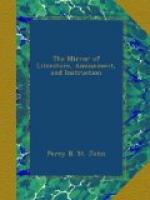Holbein is the man who has been hitherto considered as the most brilliant genius Switzerland has produced in the art of painting. He is here universally believed to have been a native of Switzerland. His earliest biographers, Mander and Patin, asserted that he was born at Basel, and they have been copied by all our biographical dictionaries. Another biographer, however, appears, himself a Swiss, and known as the author of some other clever works, and proves, on the most satisfactory evidence, that Holbein was born 1498, at Augsburg, in Germany; but that his father, a painter too, came to Basel between 1504-8, probably at the invitation of the magistrates of Basel, as they required a painter to decorate their newly-built council-hall.
Holbein gave early proofs of his aspiring talent. When fifteen years old, he exhibited an oil-painting, which, though defective in colouring, raised high expectations by its clearness and softness of execution. This painting is still to be seen in the public library at Basel, and bears the date of 1513. Of the same year, a sketch, with the monogram HH, is extant, representing three watchmen with halberds. His two brothers were also painters; only a few paintings are left of the elder, Ambrose, and none of the younger brother Bruno; both died prematurely. In the year 1520, Holbein was presented with the freedom of the town of Basel.
Switzerland held constant communications with Germany and the Netherlands, but less with Italy. A number of painters lived at that time in Germany, whose names have not been recorded by any German Vasari, and their master works have been long neglected. In Holbein’s time Albrecht Durer enjoyed the primary reputation. Martin Schoen had preceded him at Colmar, in Alsace; Manuel painted at Bern, Hans Asper at Zurich, and at Basel itself there were other painters besides Holbein. Half a century before him the Dance of Death had been painted, after the disaster of a plague, on the walls of a church-yard at Basel.
The council-hall at Basel gave occupation to architects from 1508 till 1520. It is believed that Holbein painted three of the walls, only one of which (hid behind old tapestry, and discovered again in 1817) has escaped the ravages of time. It represents M. Curius Dentatus cooking his dinner, whilst the Samnites offer silver plates with money. “The last Judgment,” where a pope, with priests and monks, sink into the flames of hell, is not the work of Holbein, but was done in 1610, during good Protestant times.
A good number of stories are told of Holbein. Unable to pay his debts in a tavern, he discharged the bill by decorating the walls with paintings of flowers. Another time, for a similar purpose, he covered the walls all over with “the merry dance of peasants;” and in order to deceive one of his employers, he painted his own legs beneath the high scaffolding, that the watchful citizen should not suspect his having abandoned his work to carouse




